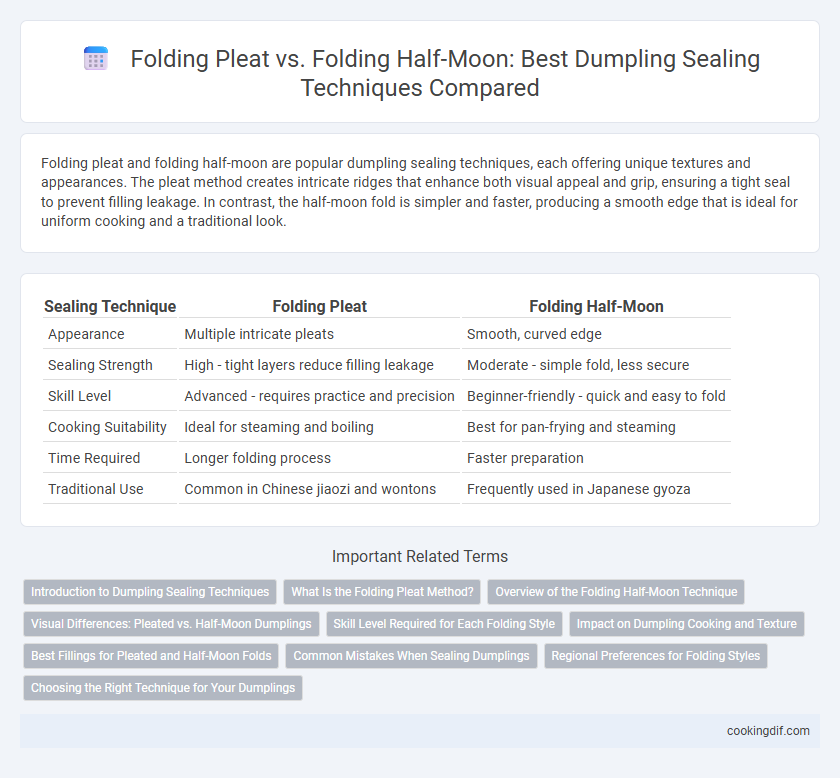Folding pleat and folding half-moon are popular dumpling sealing techniques, each offering unique textures and appearances. The pleat method creates intricate ridges that enhance both visual appeal and grip, ensuring a tight seal to prevent filling leakage. In contrast, the half-moon fold is simpler and faster, producing a smooth edge that is ideal for uniform cooking and a traditional look.
Table of Comparison
| Sealing Technique | Folding Pleat | Folding Half-Moon |
|---|---|---|
| Appearance | Multiple intricate pleats | Smooth, curved edge |
| Sealing Strength | High - tight layers reduce filling leakage | Moderate - simple fold, less secure |
| Skill Level | Advanced - requires practice and precision | Beginner-friendly - quick and easy to fold |
| Cooking Suitability | Ideal for steaming and boiling | Best for pan-frying and steaming |
| Time Required | Longer folding process | Faster preparation |
| Traditional Use | Common in Chinese jiaozi and wontons | Frequently used in Japanese gyoza |
Introduction to Dumpling Sealing Techniques
Dumpling sealing techniques greatly influence texture and cooking results, with folding pleat and folding half-moon being the most common methods. Folding pleats create a series of precise, overlapping folds that ensure a tight seal while providing an elegant appearance, often used in Chinese dumplings like jiaozi. Folding half-moon involves simply folding the dough over the filling and pressing the edges together, offering a faster but less decorative seal ideal for quick preparation and steaming.
What Is the Folding Pleat Method?
The folding pleat method involves creating multiple small, sharp folds along the edge of the dumpling wrapper to securely seal the filling inside, forming a series of precise pleats that enhance both appearance and structural integrity. This technique ensures uniform cooking by evenly distributing the dough thickness and helps prevent leakage during steaming or boiling. Compared to the folding half-moon method, the pleat method provides a more intricate and visually appealing finish, commonly used for traditional dumplings like Chinese jiaozi or Japanese gyoza.
Overview of the Folding Half-Moon Technique
The Folding Half-Moon technique involves folding the dumpling wrapper in half over the filling and pressing the edges together to create a smooth, crescent-shaped seal. This method is favored for its simplicity and efficiency, resulting in evenly sealed dumplings that prevent leakage during cooking. Unlike the Folding Pleat technique, it offers a sleek, minimalist appearance and faster preparation without intricate folds.
Visual Differences: Pleated vs. Half-Moon Dumplings
Folding pleat dumplings feature multiple small folds creating a textured, ridged edge that enhances grip and visual appeal, resembling a fan or shell. In contrast, folding half-moon dumplings have a smooth, curved seam with no intricate pleats, showcasing simplicity and a clean line. These visual differences not only affect presentation but also influence cooking methods and filling distribution inside the dumpling.
Skill Level Required for Each Folding Style
Folding pleat dumplings demand advanced skill with precise, consistent pleats ensuring even cooking and aesthetic appeal, typically mastered by experienced chefs. Folding half-moon dumplings require a more basic technique, focusing on a simple fold and seal, suitable for beginners or quick preparation without compromising the seal's integrity. Mastery of folding pleats enhances overall dumpling texture and presentation, while half-moon folds prioritize efficiency and ease.
Impact on Dumpling Cooking and Texture
Folding pleat techniques create multiple layered folds that enhance dumpling texture by producing a chewier, more complex bite and ensuring even cooking by trapping steam inside. Folding half-moon seals offer a simpler, uniform edge that promotes consistent heat distribution but results in a smoother, softer texture. The choice between these sealing methods directly influences dumpling elasticity and moisture retention during steaming or boiling.
Best Fillings for Pleated and Half-Moon Folds
Filling moisture content and texture influence the effectiveness of pleated and half-moon folds in dumpling sealing techniques. Pleated folds best suit fillings with denser, chunkier ingredients like minced pork and vegetables that hold shape well, ensuring the pleats stay intact during cooking. Half-moon folds complement softer, moister fillings such as shrimp or tofu mixtures, allowing for a secure seal without tearing the thin dough.
Common Mistakes When Sealing Dumplings
Common mistakes when sealing dumplings involve improper folding techniques like uneven pleats or insufficient pinching, leading to gaps that cause filling leakage during cooking. Folding pleats require consistent pressure and precise alignment to prevent dough tearing, while half-moon seals often fail if edges are not moistened adequately for a strong bond. Ensuring uniform thickness and avoiding overfilling are crucial to maintain dumpling integrity regardless of the folding style used.
Regional Preferences for Folding Styles
Folding pleat and folding half-moon techniques reflect distinct regional preferences in dumpling preparation, with pleated folds commonly associated with Northern Chinese cuisine for their decorative appeal and enhanced sealing strength. The half-moon fold, prevalent in Southern China and Korea, offers a simpler, faster sealing method favored for its rustic and practical style. These regional folding choices not only influence dumpling appearance but also affect texture and cooking outcomes, showcasing cultural cooking traditions.
Choosing the Right Technique for Your Dumplings
Selecting the right sealing technique for dumplings depends on both the desired texture and presentation. Folding pleat creates intricate, ridged edges that enhance the dumpling's structure and visual appeal, perfect for steamed varieties, while folding half-moon offers a simpler, smooth seal ideal for pan-frying or boiling, ensuring even cooking and easy sealing. Understanding the dough's thickness and filling moisture also guides the choice, as pleats require pliable dough and less wet filling to maintain crispness and shape.
Folding Pleat vs Folding Half-Moon for sealing techniques Infographic

 cookingdif.com
cookingdif.com